园艺专业英语(课后翻译)
- 格式:doc
- 大小:41.00 KB
- 文档页数:3
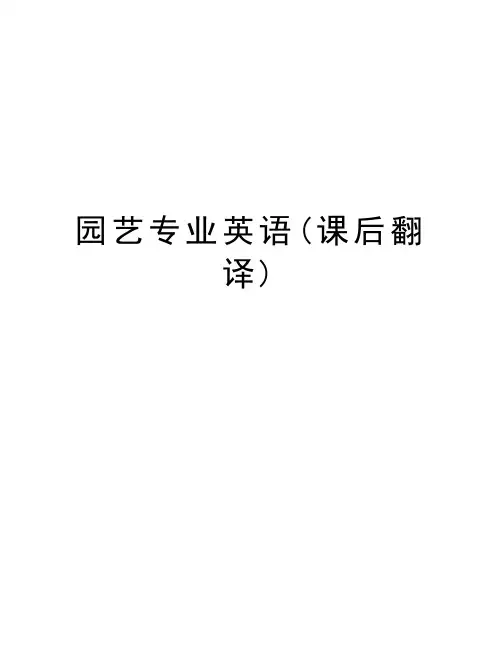
园艺专业英语(课后翻译)园艺专业英语翻译(中→英)Lesson1 part A1、protected (structure) horticulture is defined as a cultivation method taking use of heatkeeping ,chilling prevention or cooling and rainproof facilities to prevent the crops production from being influenced or seriously done by natural seasons and to artificially create a microclimateenvironment suitable for growing horticultural crops in cold or hot weather hat actually unfavorable to the crop development .it is also termed as out-of-season culture ,season-off culture or forcingculture .because of the season in which horticultural crops are planted is hand for their growing inopen field.2、Windbreak、cold –frame 、hot-frame、 plastic-clad tunnel and greenhouse could provide a varietyof vegetable seeding for open field or protected culture or protect seeding of cold tolerant vegetable living through the winter ,for early planting and acquirement of early mature products.3、In respect of structure type, the largest horticultural structure area in our country consists of plastictunnels and lean to houses, especially the energy-sawing solar greenhouse, which has become thedominant greenhouse type in the country. Presently the development of large greenhouse or multi-span house has been initiated.Lesson2 part A4、In horticultural crop cultivation under structure the key point of environment management forgrowers is to create optimal complex of environmental conditions for crop growth and development, as possibly as they can, according to properties and environmental demand of crop.Lesson3 part ALesson4 part A1、most soil amendments are consisted of the increasing of organic matters ,addition of specificnutritional elements and ph adjustment2、the soil is an important constitute of the land loamy soil must consist of soul particles with properratio ,with equilibrium of nutrients ,in which contains some organic matter ,and with considerablemoistureLesson5 part ALesson6 part A1、sink demand of horticultural crops extremely affects photosynthetic ,for example ,leaf photosynthesisnoticeably decrease when potato tubers are removed during their growth short-term response may be stomato close effect ,but this cannot explain common continuous effects ,sometime when the source-sink ratio increases significantly ,some old leaves can renew their photosynthesis functions ,on the other hand ,rapidly growing sinks sometimes compete with leaves for mobilizable nitrogen and this results in abscission of leaves and lower photosynthesis capacity.2、It is not clear yet that how the sink demand affect photosynthesis of leaves .the simplest explanationis that photosynthesis accumulated in leaves restrain photosynthesis . however trials for examiningthis hypothesis usually obtained the opposite results .furthermore ,in practice ,photosynthates seemly not accumulate beside chloroplasts in mesophyll cells .thus ,more research work should be done on source-sink relationship to improve yields of horticultural cropsLesson7 part A1、the development of horticultural crops product organs consist of maturity 、full ripeness andsenescence stages .maturity includes physiological ripeness and horticultural ripeness the formermeans that in the last growth stage ,mature organs become full ripening and the later means the best growth stage of horticultural crops for harvest ,such as leaf vegetables ,when they are reaped ,they are not physiological ripe ,and flower crops are harvested when thy flower.Full ripeness is the develop stage after fruit mature some fruits can get full ripeness in trees ,while some must ripen after separated from trees .after full ripen the flesh mealiness aroma strength proper acidity and sugar ,senescence is a stopping terminating process of living activity. In this stage,product organs quality of horticultural crops become bad and completely leaves their economicalvalue in the endLesson8 part A1、hormone produced by seed influence fruit setting ,fruit growth and the balance of hormones in plant2、Stone fruits can no t set their fruits when their embryos develop abnormally. pome fruits can setwithout seeds ,but flesh cells grow slowly3、Gibberellins was produced after pollination with seed development gibberellins promotes synthesisof auxin , therefore ,promotes fruit setting .the fruit set and fruit growth is similar between the ovule not pollinated treated by gibberellins and those which has seed4、Gibberellins produced by apple seeds apparently restrain flower differentiation and result in alternatefruiting .alternate fruiting is not normal in pear and many stone fruits .it is because the earlyoccurrence of gibberellins synthesis peak which is not concurrent with flower differentiationinitiation.Lesson13 part A1、pruning of fruit trees is a practice involves the heading back cuts and the thinning cuts of branchesfor good framework ,for regulating contradiction between growth and fruiting ,for maintaining the equilibrium between vegetative growth and propagative growth and for good sunlight exposure, to fruit early to achieve high yield and to get commodity with high quality2、the pruning methods are best determined by the characteristics of fruit species and cultivars ,theclimate the soil condition and the crop developing stages and growth status .in order to get the best result ,it is useful to combine pruning with other cultural practices like fertilization ,irrigation, etc 3、Reinvigoration of trees is better performed annually, which can keep fruit from stimulating excessivesprouts .remove dead branches, sprouts and some crossing shoots. Secondly, large branches should be thinned out gradually to open tree chamber and to improve distribution of sunlight in order tosimulate fruiting.Lesson15 part A1、temperature is an critical element in biological ,chemical and physiological processes of all plantspecies2、Temperature regulates the rate of chemical reactions ,leading to the adjustment of plant growth rate.3、As a important contributing factor to climate .temperature play an important role in adaptability andgrowth ,date of plant thus the horticultural crop types which can be cultured in a specific area rely on temperature4、Most plants can live and grow in the range of 0 to 50℃ .however low-temperature sensitivity limitthe successful cultivated regions of plantsLesson16 part A1、sprinkler irrigation is often used in maintaining and flower beds which has the specialty the uniformwater amount in its coverage .however, water waste occur when sprinkler is not limited in the area need irrigation .in addition ,evaporation result in some water loss too。
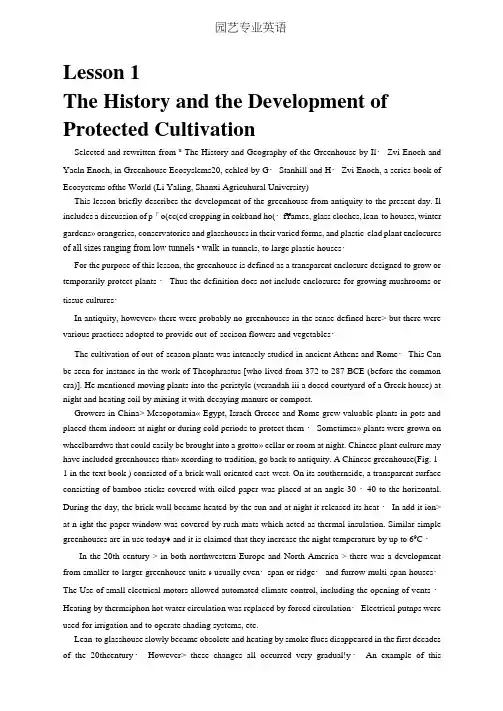
Lesson 1The History and the Development of Protected CultivationSelected and rewritten from u The History and Geography of the Greenhouse by Il・ Zvi Enoch and Yaeln Enoch, in Greenhouse Ecosyslems20, echled by G・ Stanhill and H・ Zvi Enoch, a series book of Ecosystems ofthc World (Li Yaling, Shanxi Agricuhural University)This lesson briefly describes the development of the greenhouse from antiquity to the present day. Il includes a discussion of p「o(ec(ed cropping in cokband ho(・f¥ames, glass cloches, lean-to houses, winter gardens» orangeries, conservatories and glasshouses in their varied forms, and plastic-clad plant enclosures of all sizes ranging from low tunnels • walk-in tunnels, to large plastic houses・For the purpose of this lesson, the greenhouse is defined as a transparent enclosure designed to grow or temporarily protect plants ・ Thus the definition does not include enclosures for growing mushrooms or tissue cultures・In antiquity, however» there were probably no greenhouses in the sense defined here> but there were various practices adopted to provide out-of-secison flowers and vegetables・The cultivation of out-of-season plants was intensely studied in ancient Athens and Rome・ This Can be seen for instance in the work of Theophrastus [who lived from 372 to 287 BCE (before the common era)]. He mentioned moving plants into the peristyle (verandah iii a dosed courtyard of a Greek house) at night and heating soil by mixing it with decaying manure or compost.Growers in China> Mesopotamia« Egypt, Israeh Greece and Rome grew valuable plants in pots and placed them indoors at night or during cold periods to protect them ・ Sometimes» plants were grown on wheelbarrdws that could easily be brought into a grotto» cellar or room at night. Chinese plant culture may have included greenhouses that» xcording to tradition, go back to antiquity. A Chinese greenhouse(Fig. 1-1 in the text book ) consisted of a brick wall oriented east-west. On its southernside, a transparent surface consisting of bamboo sticks covered with oiled paper was placed at an angle 30 ・40 to the horizontal. During the day, the brick wall became heated by the sun and at night it released its heat ・ In add it ion> at n ight the paper window was covered by rush mats which acted as thermal insulation. Similar simple greenhouses are in use today♦ and it is claimed that they increase the night temperature by up to 69C ・In the 20th century > in both northwestern Europe and North America > there was a development from smaller to larger greenhouse units 9 usually even・span or ridge・ and furrow multi-span houses・The Use of small electrical motors allowed automated climate control, including the opening of vents ・Heating by thermsiphon hot water circulation was replaced by forced circulation・ Electrical putnps were used for irrigation and to operate shading systems, etc.Lean-to glasshouse slowly became obsolete and heating by smoke flues disappeared in the first decades of the 20thcentury・However> these changes all occurred very gradual!y・An example of thisdevelopment in the Netherlands is outlined below・Simple over-winter sheds were used in Aalsmeer, the Netherlands, up to the 1920% and storc-framcst placed against the walls to protect vines in the Westland region were photographed in 1928.At the beginning of the 20th century, 90 % of the area used for protected cultivation in the Netherlands consisted of cold frames or hotbeds (heated by decomposition of manure and compost)・ By 1950, the area was still about 30%, and in 1964 it was 10% ・The use of Dutch lights was introduced at the beginning of the 20th century. Initially, only single-span frames were used; double -light frames date from about 1920・ Comparing the building practices in the Netherlands with those in the more advanced United States» one sees that in 1904, 90 % of the glass-covered area in the Netherlands con sisted of light frames ・ while 25 % of the glass・covered area in the US A in the year 1900 was of proper glasshouses ・ The area under glass in the Netherlands increased from 1.6 km2 in 1904 to 4.0 km2 in 1912, to 32. 9 km2 in 1950, reaching 60.2 knf in 1964.Heating and carbon-dioxide fertilization of hotbed through the decomposition of mixtures of horse manure and plant residues was widely used in the Netherlands at the beginning of the last century, and remained the com IT Ion way for growing cucumbers and melons until horses were replaced by tractors in the years after the Second World War.Claassen and Haze loop (1933)mentioned that at that time flue heaters were only used by a few growen; in the Netherlands♦ whereas in Belgium* most of the 4.40 kirT used for fruit-growing in 1939 was heated by flues. Dutch greenhouses suitable tor a variety of crops were developed gradually over half a century. In 1900, at Loosduinen» a steel-framed greenhouse was built which became the forerunner for the “\Enlo Warenhuis\ a house that could be used for different crops ・ This glasshouse» first built in 1937, consists of large sheets of glass held within the grooves of the two sides of a separating narrow steel bar, permitting the maxinium transmission of light・V?nlo-typc structures (Fig・1・2) were becoming popular ill Westland of the Netherlands iii the 1950's ・ Burning natural gas for the supply of carbon dioxide to greenhouse crops began in the Netherlands in 1961» following work done by J・ Stender from the Institute of Horticultural Engineering in Wageningen, and became globally applied over the next decade・ Glossary 1.glass cloche园艺用钟形玻璃西(E钟形玻璃罩,一种通常呈钟状的罩子,主耍用丁保护植物避免严寒冻害)2.cold-and hot-frame 阳畦和温床3.Ican-to house 一面坡温室,单屋面温室4.winter garden冬季花园(或菜园)5.orangery 柑橘温室,橘园,养橘温室(a sheltered placet especially a greenhouse»used for the cultivation of orange trees in cool climates)6・ conscrvatoiy 话人室(a greenhouse。
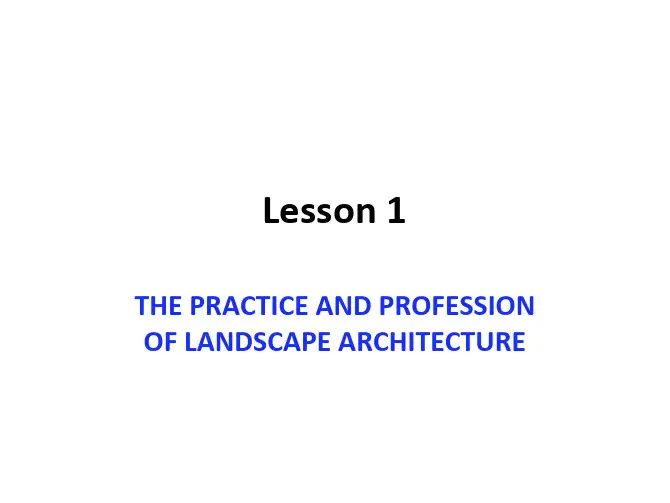
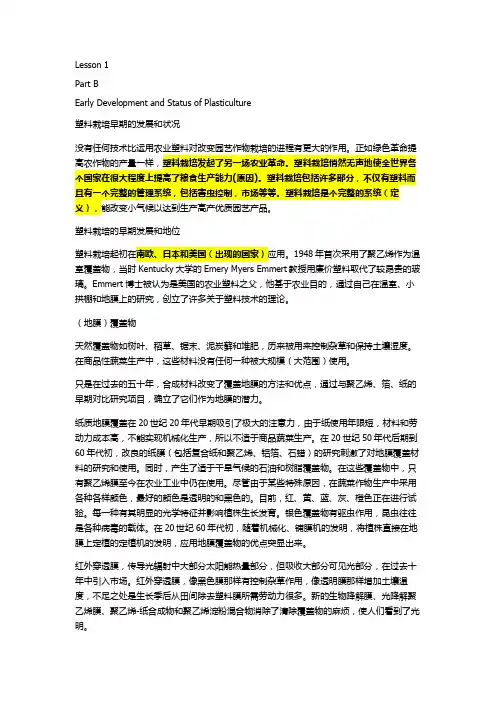
Lesson 1Part BEarly Development and Status of Plasticulture塑料栽培早期的发展和状况没有任何技术比运用农业塑料对改变园艺作物栽培的进程有更大的作用。
正如绿色革命提高农作物的产量一样,塑料栽培发起了另一场农业革命。
塑料栽培悄然无声地使全世界各个国家在很大程度上提高了粮食生产能力(原因)。
塑料栽培包括许多部分,不仅有塑料而且有一个完整的管理系统,包括害虫控制,市场等等。
塑料栽培是个完整的系统(定义),能改变小气候以达到生产高产优质园艺产品。
塑料栽培的早期发展和地位塑料栽培起初在南欧、日本和美国(出现的国家)应用。
1948年首次采用了聚乙烯作为温室覆盖物,当时Kentucky大学的Emery Myers Emmert教授用廉价塑料取代了较昂贵的玻璃。
Emmert 博士被认为是美国的农业塑料之父,他基于农业目的,通过自己在温室、小拱棚和地膜上的研究,创立了许多关于塑料技术的理论。
(地膜)覆盖物天然覆盖物如树叶、稻草、锯末、泥炭藓和堆肥,历来被用来控制杂草和保持土壤湿度。
在商品性蔬菜生产中,这些材料没有任何一种被大规模(大范围)使用。
只是在过去的五十年,合成材料改变了覆盖地膜的方法和优点,通过与聚乙烯、箔、纸的早期对比研究项目,确立了它们作为地膜的潜力。
纸质地膜覆盖在20世纪20年代早期吸引了极大的注意力,由于纸使用年限短,材料和劳动力成本高,不能实现机械化生产,所以不适于商品蔬菜生产。
在20世纪50年代后期到60年代初,改良的纸膜(包括复合纸和聚乙烯、铝箔、石蜡)的研究刺激了对地膜覆盖材料的研究和使用。
同时,产生了适于干旱气候的石油和树脂覆盖物。
在这些覆盖物中,只有聚乙烯膜至今在农业工业中仍在使用。
尽管由于某些特殊原因,在蔬菜作物生产中采用各种各样颜色,最好的颜色是透明的和黑色的。
目前,红、黄、蓝、灰、橙色正在进行试验。
每一种有其明显的光学特征并影响植株生长发育。
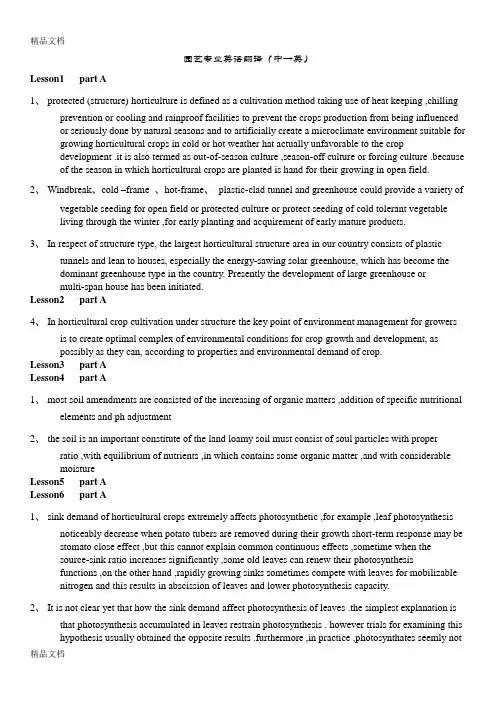
园艺专业英语翻译(中→英)Lesson1 part A1、protected (structure) horticulture is defined as a cultivation method taking use of heat keeping ,chillingprevention or cooling and rainproof facilities to prevent the crops production from being influenced or seriously done by natural seasons and to artificially create a microclimate environment suitable for growing horticultural crops in cold or hot weather hat actually unfavorable to the cropdevelopment .it is also termed as out-of-season culture ,season-off culture or forcing culture .because of the season in which horticultural crops are planted is hand for their growing in open field.2、Windbreak、cold –frame 、hot-frame、plastic-clad tunnel and greenhouse could provide a variety ofvegetable seeding for open field or protected culture or protect seeding of cold tolerant vegetableliving through the winter ,for early planting and acquirement of early mature products.3、In respect of structure type, the largest horticultural structure area in our country consists of plastictunnels and lean to houses, especially the energy-sawing solar greenhouse, which has become thedominant greenhouse type in the country. Presently the development of large greenhouse ormulti-span house has been initiated.Lesson2 part A4、In horticultural crop cultivation under structure the key point of environment management for growersis to create optimal complex of environmental conditions for crop growth and development, aspossibly as they can, according to properties and environmental demand of crop.Lesson3 part ALesson4 part A1、most soil amendments are consisted of the increasing of organic matters ,addition of specific nutritionalelements and ph adjustment2、the soil is an important constitute of the land loamy soil must consist of soul particles with properratio ,with equilibrium of nutrients ,in which contains some organic matter ,and with considerablemoistureLesson5 part ALesson6 part A1、sink demand of horticultural crops extremely affects photosynthetic ,for example ,leaf photosynthesisnoticeably decrease when potato tubers are removed during their growth short-term response may be stomato close effect ,but this cannot explain common continuous effects ,sometime when thesource-sink ratio increases significantly ,some old leaves can renew their photosynthesisfunctions ,on the other hand ,rapidly growing sinks sometimes compete with leaves for mobilizable nitrogen and this results in abscission of leaves and lower photosynthesis capacity.2、It is not clear yet that how the sink demand affect photosynthesis of leaves .the simplest explanation isthat photosynthesis accumulated in leaves restrain photosynthesis . however trials for examining this hypothesis usually obtained the opposite results .furthermore ,in practice ,photosynthates seemly notaccumulate beside chloroplasts in mesophyll cells .thus ,more research work should be done onsource-sink relationship to improve yields of horticultural cropsLesson7 part A1、the development of horticultural crops product organs consist of maturity 、full ripeness and senescencestages .maturity includes physiological ripeness and horticultural ripeness the former means that in the last growth stage ,mature organs become full ripening and the later means the best growth stage of horticultural crops for harvest ,such as leaf vegetables ,when they are reaped ,they are notphysiological ripe ,and flower crops are harvested when thy flower.Full ripeness is the develop stage after fruit mature some fruits can get full ripeness in trees ,whilesome must ripen after separated from trees .after full ripen the flesh mealiness aroma strength proper acidity and sugar ,senescence is a stopping terminating process of living activity. In this stage,product organs quality of horticultural crops become bad and completely leaves their economicalvalue in the endLesson8 part A1、hormone produced by seed influence fruit setting ,fruit growth and the balance of hormones in plant2、Stone fruits can no t set their fruits when their embryos develop abnormally. pome fruits can set withoutseeds ,but flesh cells grow slowly3、Gibberellins was produced after pollination with seed development gibberellins promotes synthesis ofauxin , therefore ,promotes fruit setting .the fruit set and fruit growth is similar between the ovule not pollinated treated by gibberellins and those which has seed4、Gibberellins produced by apple seeds apparently restrain flower differentiation and result in alternatefruiting .alternate fruiting is not normal in pear and many stone fruits .it is because the earlyoccurrence of gibberellins synthesis peak which is not concurrent with flower differentiationinitiation.Lesson13 part A1、pruning of fruit trees is a practice involves the heading back cuts and the thinning cuts of branches forgood framework ,for regulating contradiction between growth and fruiting ,for maintaining theequilibrium between vegetative growth and propagative growth and for good sunlight exposure, to fruit early to achieve high yield and to get commodity with high quality2、the pruning methods are best determined by the characteristics of fruit species and cultivars ,the climatethe soil condition and the crop developing stages and growth status .in order to get the best result ,it is useful to combine pruning with other cultural practices like fertilization ,irrigation, etc3、Reinvigoration of trees is better performed annually, which can keep fruit from stimulating excessivesprouts .remove dead branches, sprouts and some crossing shoots. Secondly, large branches should be thinned out gradually to open tree chamber and to improve distribution of sunlight in order tosimulate fruiting.Lesson15 part A1、temperature is an critical element in biological ,chemical and physiological processes of all plant species2、Temperature regulates the rate of chemical reactions ,leading to the adjustment of plant growth rate.3、As a important contributing factor to climate .temperature play an important role in adaptability andgrowth ,date of plant thus the horticultural crop types which can be cultured in a specific area rely on temperature4、Most plants can live and grow in the range of 0 to 50℃ .however low-temperature sensitivity limit thesuccessful cultivated regions of plantsLesson16 part A1、sprinkler irrigation is often used in maintaining and flower beds which has the specialty the uniformwater amount in its coverage .however, water waste occur when sprinkler is not limited in the area need irrigation .in addition ,evaporation result in some water loss too。
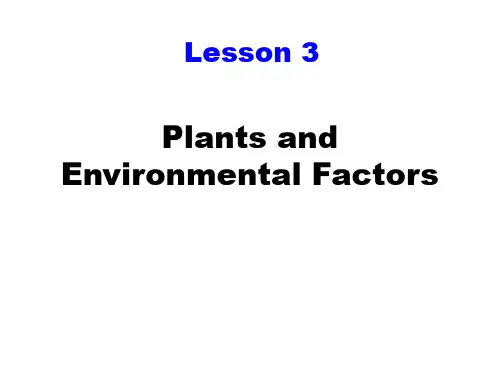

园艺专业英语课后翻译1、设施园艺是指在不适宜园艺作物生长发育的寒冷或炎热季节,利用保温、防寒或降温防雨设施,人为地创造适宜园艺作物生长发育的小气候环境,使园艺作物的生产不受或少受自然季节的影响。
由于其生产季节往往是在露地自然环境下难以生产的季节,故又称其为“反季节栽培”、“促成栽培”。
Protected (structure) horticulture is defined as a cultivation method taking use of heat keeping ,chilling prevention or cooling and rainproof facilities to prevent the crops production from being influenced or seriously done by natural seasons and to artificially create a icroclimate environment suitable for growing horticultural crops in cold or hot weather hat actually unfavorable to the crop development .it is also termed as out-of-season culture ,season-off culture or forcing culture .because of the season in which horticultural crops are planted is hand for their growing in open field.2、风障、阳畦、温床、塑料棚及温室可为露地和保护地培育各种蔬菜幼苗,或保护耐寒性蔬菜的幼苗越冬,以便提早定植,获得早熟品种。
Windbreak、cold –frame 、hot-frame、plastic-clad tunnel and greenhouse could provide a variety of vegetable seeding for open field or protected culture or protect seeding of cold tolerant vegetable living through the winter ,for early planting and acquirement of early mature products.3、从设施类型看,我国园艺设施栽培面积最大的是塑料拱棚和单屋面温室,尤其是不加温的节能型日光温室,已经成为我国温室的主导类型。
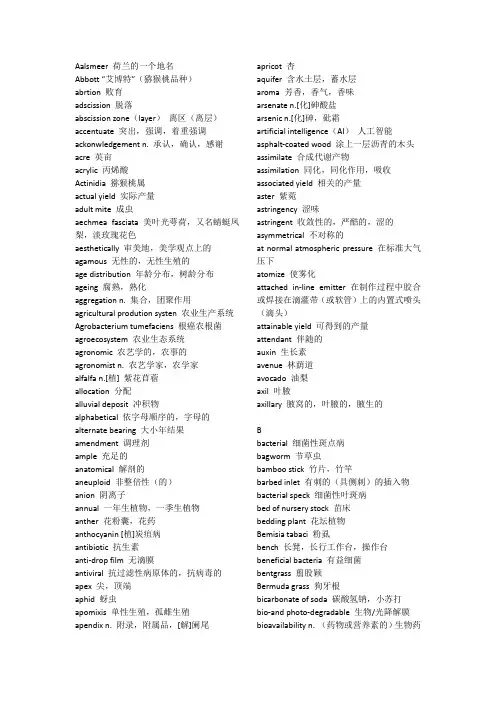
Aalsmeer 荷兰的一个地名Abbott “艾博特”(猕猴桃品种)abrtion 败育adscission 脱落abscission zone(layer)离区(离层)accentuate 突出,强调,着重强调ackonwledgement n. 承认,确认,感谢acre 英亩acrylic 丙烯酸Actinidia 猕猴桃属actual yield 实际产量adult mite 成虫aechmea fasciata 美叶光萼荷,又名蜻蜓凤梨,淡玫瑰花色aesthetically 审美地,美学观点上的agamous 无性的,无性生殖的age distribution 年龄分布,树龄分布ageing 腐熟,熟化aggregation n. 集合,团聚作用agricultural prodution systen 农业生产系统Agrobacterium tumefaciens 根癌农根菌agroecosystem 农业生态系统agronomic 农艺学的,农事的agronomist n. 农艺学家,农学家alfalfa n.[植] 紫花苜蓿allocation 分配alluvial deposit 冲积物alphabetical 依字母顺序的,字母的alternate bearing 大小年结果amendment 调理剂ample 充足的anatomical 解剖的aneuploid 非整倍性(的)anion 阴离子annual 一年生植物,一季生植物anther 花粉囊,花药anthocyanin [植]炭疽病antibiotic 抗生素anti-drop film 无滴膜antiviral 抗过滤性病原体的,抗病毒的apex 尖,顶端aphid 蚜虫apomixis 单性生殖,孤雌生殖apendix n. 附录,附属品,[解]阑尾apricot 杏aquifer 含水土层,蓄水层aroma 芳香,香气,香味arsenate n.[化]砷酸盐arsenic n.[化]砷,砒霜artificial intelligence(AI)人工智能asphalt-coated wood 涂上一层沥青的木头assimilate 合成代谢产物assimilation 同化,同化作用,吸收associated yield 相关的产量aster 紫菀astringency 涩味astringent 收敛性的,严酷的,涩的asymmetrical 不对称的at normal atmospheric pressure 在标准大气压下atomize 使雾化attached in-line emitter 在制作过程中胶合或焊接在滴灌带(或软管)上的内置式喷头(滴头)attainable yield 可得到的产量attendant 伴随的auxin 生长素avenue 林荫道avocado 油梨axil 叶腋axillary 腋窝的,叶腋的,腋生的Bbacterial 细菌性斑点病bagworm 节草虫bamboo stick 竹片,竹竿barbed inlet 有刺的(具侧刺)的插入物bacterial speck 细菌性叶斑病bed of nursery stock 苗床bedding plant 花坛植物Bemisia tabaci 粉虱bench 长凳,长行工作台,操作台beneficial bacteria 有益细菌bentgrass 翦股颖Bermuda grass 狗牙根bicarbonate of soda 碳酸氢钠,小苏打bio-and photo-degradable 生物/光降解膜bioavailability n. (药物或营养素的)生物药效率,生物利用度bio-inoculate 生物接种biological agent 生物制剂,生物作用biological control 生物防治,生物学控制biomass 生物量biopesticide 生物农药biotechnology 生物技术bitter pit 苦心病bitterness 苦味bivalent 二价的blackberry 黒莓black-yellow striped 黒黄相间带状的bloom 花blossom-end rot(BER)蒂腐blossom-end rot fruit 蒂腐果blueberry 越橘bluegrass 早熟禾bog 沼泽,沼泽地bollworm 棉铃虫bombardment 炮击,轰击border soil 边界土壤,边际土壤,表层土壤botanical 植物性药材,植物学的botanical garden 植物园botanically 植物学上branch 分枝branchlet 细小的枝条broken or dotted line 虚线bruise 搽伤,挫伤Bruno "布鲁诺"(猕猴桃品种)bucket 提篮bud cutting 芽插budding 芽接法budworm 食心虫,卷叶蛾buffer capacity 缓冲能力build 体型bulb 球根,鳞茎bulldozing 推土机推土bumblebee(bumble-bee)熊蜂,土蜂burr (多)刺果皮,(多)刺果,刺球状花序,刺球butterfly bush 大叶醉鱼草Ccalcium n.[化]钙(元素符号Ca)calyx 萼片(总称)cambium 形成层cane hoop 竹竿拱架cane 蔓canopy 冠层,株冠;罩篷,遮篷canopy configuration 冠层结构cantaloupe 罗马甜瓜,香瓜,哈密瓜canvas 帆布cap 罩式覆盖capillary matting 具毛孔的垫子carbonate 碳酸盐;vt.使变成碳酸盐,使充满二氧化碳carnation 香石竹,康乃馨carnation flower 荷兰石竹,康乃馨carotenoid [生化]类胡萝卜素carpel [植]心皮carrying virus 携带病毒catfacing 畸形(果实表面凹凸不平)cation 阳离子cation exchange capacity 阳离子交换量catkin 柔荑花序cefotaxime 氨噻肟头孢霉素cellar 地窖,地下室cellophane 玻璃纸胶膜celosia 青葙centipedegrass 百足草central leader 中心领导枝central leader system 中心领导枝树形centrifugal 离心的centrifuge 离心cherry 樱桃chestnut 粟子chewings fescue 紫羊茅Chico '齐克'(猕猴桃品种)Chico Hayward '齐克海沃德'(猕猴桃品种)Chinese gooseberry 中华鹅莓(猕猴桃的原称)chlorophyll 叶绿素chloroplast 叶绿体chlorosis 失绿症,萎黄病,变色病cholesterol 胆甾醇,胆固醇chrysanthemum 菊花circle(or pie)diagram 饼图,圆形图,百分比图clamp 钳clay fraction 黏粒clear film 透明膜clogging adj. 障碍的,阻塞的clonal [生]无性(繁殖)系的clone 无性系,无性繁殖,克隆cluster 串,丛,果穗,(总状)花序coconut椰子cognizance 认识,识别coincubate 共培养coir pith(coconuts)椰子壳纤维colchicine 秋水仙碱,秋水仙素cold-and hot-frame 阳畦和温床collaborative adj. 合作的,协作的,协力完成的colloidal adj. 胶状的,胶质的commercial fertilizer 化肥,商业化肥commercial horticulture 商品化园艺,市场化园艺commodity 商品common era 基督时代与公元相符合的时期compact plant 紧凑的株型compost 堆肥composted bark(bark compost)混合树皮compound pinnate [植]羽状复叶concomitant noxious gases 伴随的有害气体consecutive adj. 连续的,连贯的conservation of energy [物]能量守恒conservation of mass [物]质量守恒conservatory 暖房,温室consistent 一致的conspicuous 显而易见的consultancy bureaus 顾问局container-grown nursery stock 容器中栽培的苗木contaminant 污染物control daylength 控制日长controlled environment agriculture (CEA)控制环境农业cooling n. 冷却,adj. 冷却的corolla 花冠corsage 装饰女服上身或肩部的小花束cosmos 大波斯菊cost management 成本管理cotton aphid 棉蚜cotyledon 子叶cranberry 大果酸果蔓,蔓越橘creeping red fescue 匍匐紫羊茅crispness 脆crop condition 作物状况crop planning 种植计划crop vitality 作物的活力或生命力cross 杂交cross-pollination 异花授粉crotch 树杈cu ft 立方英尺cucurbit plant 葫芦科作物cultivar 品种cultivation under cover 保护地栽培cultural practice 栽培措施,栽培技术,栽培实践culture system 栽培系统curb 路边currant 黒醋粟cut flower 切花,鲜切花cutting 插枝,插穗cyanobacteria 蓝藻细菌cyclamen 仙客来cyme 聚伞花序cytokinin 细胞激动素Ddead load 恒载decaying manure or compost 腐熟的农家肥或堆肥deciduous 落叶的,脱落的deciduous plant 落叶植物decimal adj. 十进的,小数的,以十为基础的;n. 小数,十进制Decision Support Systems(DSS)决策支持系统decomposition n. 分解,腐烂deduce vt. 推论,演绎出defect 缺陷deficiency symptom 缺素症deficient 缺少,不足defoliate 除叶,使…落叶deformation 变形,变态,形变,畸形dehvdrated scale 脱水鳞片dehydration 脱水delicate 容易损坏的delphinidin 飞燕草色素depletion 损耗desaturase 去饱和酶deterioration 腐烂detract 转移devise vt. 设计,发明,图谋,做出(计划),想出(办法),遗赠给dew point 露点diabase 辉绿岩Dianthus 石竹dicotyledonous 双子叶植物的DIF temperature 昼夜逆温差dilution 稀释,稀释法,冲淡物dimension n. 尺寸,尺度,维(数),度(数),元dioecious 雌雄异体(株)的dioecism 雌雄异株,雌雄异体Diospyros kaki 柿diploid 二倍体(的),双重的,倍数的,双倍的,倍数染色体directional stimuli 定向刺激,定向促进disarmed strain 可转化态菌株disbud 除芽discing 圆盘耙耙地,圆盘耙耙作disinfectant 杀菌剂disjointed 脱节的,杂乱的disorder 病dispersion 分散(体,相,体系,作用,系统);弥散(现象),色(消)散,散射,传播,悬漂(液)disposable income 纯收入disposal of waste plastic 废旧塑料的处理distal end 末端distilled water 蒸馏水ditch for against freezing 防寒沟divert 转向domesticate 驯养,驯化domesticated animal 驯养动物dominant 优势的dormancy 冬眠double cap 双层罩式覆盖double-light frame 双面进光骨架double-roofed glasshouse 双屋面温室drip irrigation system 滴灌系统drip irrigation 滴灌drip tape 滴灌带driving force 驱动力drop condensation 冷凝滴水drupe 核果dry matter content 干物质含量durability 耐久性Dutch lights 荷兰土温室dwarf cultivar 矮化品种dwarfing rootstock 矮化砧dynamic flowers 动态花卉Eearly blight 早疫病ebb-and-flood 落潮涨潮,水位的降低和升高ecology 生态学egg 卵elaborate adj. 精心制作的,详细阐述的,精细;vt. 精心制作,详细阐述electrical conductivity(EC)电导度electrodyne 静电喷雾器elcit 引起emasculate 使弱embed 嵌入embryo 胚,胚胎emissivity 发射率emitter 发射器,喷头,滴头emotional value 情感方面的价值Encarsia formosa 一种小的寄生蜂enclosure n. 围住,围栏encode 编码,把…译成电码,代码化endogenous 内源的,内生的endosperm [植]胚乳endosulfan 硫丹energy balance 能量平衡energy expenditure 能量支出,能量花费energy saving 节能energy-saving greenhouse 节能温室enhance 改进enrichment 增添entity 实体environmentally-conscious 具有环境意识的enzyme 酶epidermis 表皮equilibrium n. 平衡,平静,均衡,保持平衡的能力erect 直立的(茎)ethnic 不同民族的ethylene 乙烯Eucalyptus 桉树evaporation n. 蒸发(作用)even-span greenhouse 等屋面温室even-span 等屋面的exogenous 外生的,[地]外成的。
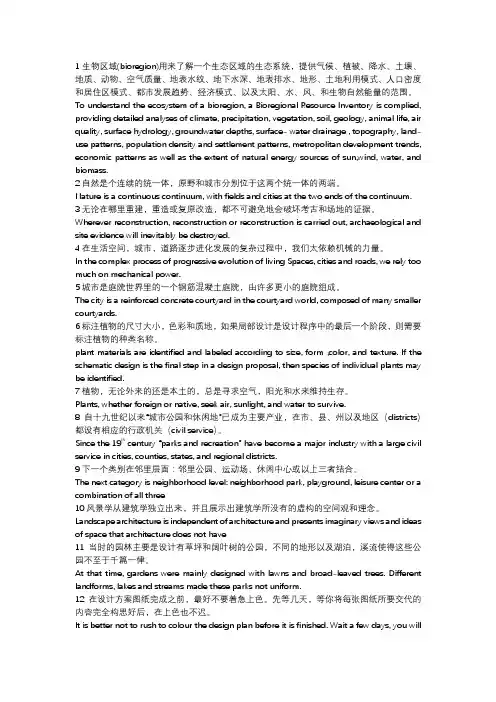
1生物区域(bioregion)用来了解一个生态区域的生态系统,提供气候、植被、降水、土壤、地质、动物、空气质量、地表水纹、地下水深、地表排水、地形、土地利用模式、人口密度和居住区模式、都市发展趋势、经济模式、以及太阳、水、风、和生物自然能量的范围。
To understand the ecosystem of a bioregion, a Bioregional Resource Inventory is complied, providing detailed analyses of climate, precipitation, vegetation, soil, geology, animal life, air quality, surface hydrology, groundwater depths, surface- water drainage , topography, land-use patterns, population density and settlement patterns, metropolitan development trends, economic patterns as well as the extent of natural energy sources of sun,wind, water, and biomass.2自然是个连续的统一体,原野和城市分别位于这两个统一体的两端。
Nature is a continuous continuum, with fields and cities at the two ends of the continuum.3无论在哪里重建,重造或复原改造,都不可避免地会破坏考古和场地的证据。
Wherever reconstruction, reconstruction or reconstruction is carried out, archaeological and site evidence will inevitably be destroyed.4在生活空间,城市,道路逐步进化发展的复杂过程中,我们太依赖机械的力量。
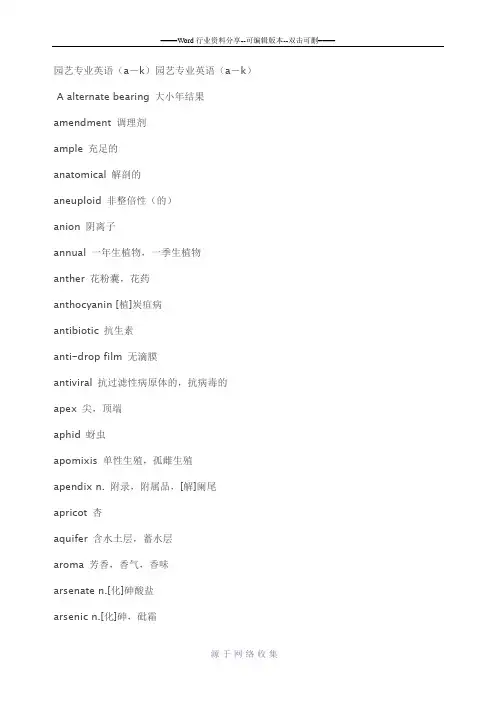
园艺专业英语(a-k)园艺专业英语(a-k) A alternate bearing 大小年结果amendment 调理剂ample 充足的anatomical 解剖的aneuploid 非整倍性(的)anion 阴离子annual 一年生植物,一季生植物anther 花粉囊,花药anthocyanin [植]炭疽病antibiotic 抗生素anti-drop film 无滴膜antiviral 抗过滤性病原体的,抗病毒的apex 尖,顶端aphid 蚜虫apomixis 单性生殖,孤雌生殖apendix n. 附录,附属品,[解]阑尾apricot 杏aquifer 含水土层,蓄水层aroma 芳香,香气,香味arsenate n.[化]砷酸盐arsenic n.[化]砷,砒霜artificial intelligence(AI)人工智能asphalt-coated wood 涂上一层沥青的木头assimilate 合成代谢产物assimilation 同化,同化作用,吸收associated yield 相关的产量aster 紫菀astringency 涩味astringent 收敛性的,严酷的,涩的asymmetrical 不对称的at normal atmospheric pressure 在标准大气压下atomize 使雾化attached in-line emitter 在制作过程中胶合或焊接在滴灌带(或软管)上的内置式喷头(滴头)attainable yield 可得到的产量attendant 伴随的auxin 生长素avenue 林荫道avocado 油梨axil 叶腋axillary 腋窝的,叶腋的,腋生的园艺专业英语2(L-Z)Llabour-intensive production process 劳动密集型生产过程laid (lay的过去式)产(卵)landfill 垃圾掩埋法,垃圾landscape designer 园林设计师large plastic house 塑料大棚larva [复] larvae 幼虫latent heat 潜热lateral branch 侧枝lattice girder 支撑桁架lay-flat bag 平放的种植袋lay-flat duct 平铺管layout n. 规划,设计,(书刊等)编排,版面设计,(工厂等)布局图leaf area ratio 叶面积比leaf cutting 叶插leaf epidermis 叶表皮,叶上皮leaf mold 腐殖土;叶霉病leaf variegation 叶杂色性,叶色变异leaf : fruit ratio 叶果比leaf-miner 潜叶蝇leak 渗漏lean-to house 一面坡温室,单屋面温室legend 图例lepidopterous 鳞翅目的light intensity 光强light transmission 光的透射light transmissivity 透光率lightweight medium 质地较轻的基质likelihood n. 可能,可能性lily 百合,百合花limb 枝limestone 石灰石line graph 直线图,折线图,曲线图linoleic acid 亚油酸lipid 类脂,脂类,类脂化合物liquid plastic mulch 液体塑料膜load 负荷lobe 圆片locule [生物]小腔,小室,心室,室(指子房,花药等)longitudinal angel 纵向角度looper 尺蠖Loosduinen 荷兰的一个地名low tunnel 小拱棚lycopene [生物]番茄红素。

山东农业大学园艺专业英语部分单词表个人整理供考试复习专用1. agronomy [ə'ɡrɒnəmɪ]n.农艺学,农学2. meet [mi:t]vt.& vi.相遇;相识;开会;接触(某物)vt.满足;支付;迎接;经历(常指不愉快的事)n.运动会,体育比赛;猎狐运动(尤其英式英语)adj.适当的;合适的;恰当的3. contrast [ˈkɔntræst]n. 对比,对照;差异;对照物,对立面;[摄]反差;vi. 对比;形成对照;vt. 使对照,使对比;和…形成对照4. grain [ɡrein]n. 谷物,粮食;(沙,金,盐等的)颗粒;谷粒,籽粒;(木材,大理石等的)纹理; vt. 把…作成细粒;把…漆[画]成木纹;染透;刮去(皮上的)毛;vi. 成谷粒5. forage ['fɒrɪdʒ]n.牛马饲料;寻找粮草vi.搜寻(食物),尤指动物觅(食);(尤指用手)搜寻(东西)6. fiber ['faɪbə]n.光纤;(织物的)质地;纤维,纤维物质7. intensive [inˈtensiv]adj. 加强的,强烈的;[农]精耕细作的;[语]加强语意的;(农业方法)集约的; n. 加强器;[语]强义词,强调成份8. esthetic [es'θetɪk]adj.有关美的;美学的;审美的;悦目的9. gratification [ˌgrætɪfɪˈkeɪʃn] n.满足;满意;喜悦;使人满意之事10. cultivation [ˌkʌltɪˈveɪʃn]n.教养;栽培;耕作;(关系的)培植11. timber ['tɪmbə(r)]n.木材,木料;(用于建筑或制作物品的)树木;用材林,林场;素质vt.用木料支撑;备以木材12. botany [ˈbɔtəni]n. 植物学;精纺毛纱;细羊毛;13. apply [ə'plaɪ]vt. 应用,运用;申请;涂;敷(药);vi. 申请,请求,适用;适用,适合;专心致志;14. distribution [ˌdɪstrɪ'bju:ʃn] n. 分配,分布;[法](无遗嘱死亡者的)财产分配;[无线]频率分布;[电]配电;15. structure [ˈstrʌktʃə(r)]n. 结构;构造;建筑物;体系;vt. 构成,排列;安排;16. classification [ˌklæsɪfɪ'keɪʃn] n. 分类;分级;类别;(动植物等的)分类学;17. impact ['ɪmpækt]n. 碰撞,冲击,撞击;影响;冲击力;vt. 挤入,压紧;撞击;对…产生影响; vi. 冲撞,冲击;产生影响;18. visual ['vɪʒʊəl]adj. 视觉的,看得见的;光学的,视力的;形象化的;光学的;n. 画面,图象;19. ornametal本地词典无数据20. olericulture [ˈɔləriˌkʌltʃə]n. 蔬菜栽培,蔬菜园艺;21. pomology [pəʊ'mɒlədʒɪ]n. 果树栽培(学);22. floriculture ['flɔ:rɪkʌltʃə]n. 花艺,栽培花卉;23. landscape ['lændskeɪp]n. 风景;风景画;乡村风景画;地形;vt. 对…做景观美化,给…做园林美化;从事庭园设计;vi. 美化(环境等),使景色宜人;做庭园设计师;24. interiorscaping本地词典无数据25. foliage [ˈfəʊliɪdʒ]n. 植物的叶子(总称),叶子及梗和枝;树叶;26. floral ['flɔ:rəl]adj. 花的,花似的;以花装饰的;植物的,植物群的;花神的;27. potted ['pɒtɪd]adj. 盆栽的,瓶或罐装的,浓缩的;封闭式; 28. bedding [ˈbedɪŋ]n. 寝具;基底,基坑;adj. 适于花坛种植的;v. “bed“的现在分词;29. appeal [ə'pi:l]n. 上诉;[体育]诉请;呼吁;(迫切的)要求(帮助、同情等)恳求;vi. (迫切)要求;有吸引力;求助(于);提请注意;vt. 将…移交上级法院审理;30. appealing [əˈpi:lɪŋ]adj. 吸引人的,令人心动的;恳求的; v. (迫切)要求(appeal的现在分词);将…上诉;31. nursery ['nɜ:sərɪ]n. 婴儿室,幼儿园;苗圃;临时托儿所;温床,滋生地;32. lawn [lɔ:n]n. 草地,草坪;上等细麻布;33. turf [tɜ:f]n. 草皮;泥炭;<非正>地盘,势力范围;赛马场,跑马场;vt. 用草皮覆盖;<英><口>抛出;扔掉;赶走;34. maintenance ['meɪntənəns]n. 维持,保持;保养,保管;维护;维修;35. evolve [ɪ'vɒlv]vt. 使发展;使进化;设计,制订出;发出,散发;vi. 发展;[生]通过进化进程发展或发生;36. manure [məˈnʊə, -ˈnjʊə]n. 肥料,粪便;vt. 施肥;37. legume [ˈlegju:m]n. 豆科植物,豆类蔬菜;38. weed [wi:d]n. 杂草;大麻;废物;烟草;vt. 给…除杂草;除(草);消除;vi. 除草;39. storage [ˈstɔ:rɪdʒ]n. 贮存;贮藏;储藏处,仓库;贮存器,蓄电(瓶);40. botanist [ˈbɒtənɪst]n. 植物学家,研究植物的人;41. herbalist [ˈɜ:bəlɪst, ˈhɜ:-]n. 种草药的人,草药商,草药医生;42. cofounder [kəʊ'faʊndə]n. 共同创办人,共同创始人;43. nomenclature [nəˈmenklətʃə(r)] n. 系统命名法;命名(过程);(某一学科的)术语;专门名称;44. taxonomy [tæk'sɒnəmɪ]n. (生物)分类学,分类系统;45. associate [əˈsəuʃiit]vt. (使)发生联系;(使)联合;结交;联想;vi. 联盟;陪伴同事;n. 合伙人;伴侣,同志;非正式会员; adj. 联合的;合伙的;非正式的;(性质上)有密切联系的;46. deadline ['dedlaɪn]n. 最后期限;截止期限;死线;原稿截止时间;vt. 通过设定一时间期限来统治;47. personnel [ˌpɜ:səˈnel]n. 全体员工;(与复数动词连用)人员,员工;人事部门; 48. get along [ɡet əˈlɔŋ]相处;进展;前进;离去;49. dedication [ˌdedɪ'keɪʃn]n. 奉献;献身精神;教堂的)献堂礼;(书等作品上的)题词;50. adaptation [ˌædæp'teɪʃn]n. 适应,顺应;改编,改编本;适应性的改变;同化;51. annual [ˈænjuəl]adj. 每年的;一年的;[植物]一年生的; n. 年刊;一年生植物;52. petunia [pəˈtju:niə]n. 矮牵牛(花);53. biennial [baɪˈeniəl]adj. (事件)两年一次的;n. 两年生植物;54. perennial [pəˈreniəl]adj. 终年的,长久的;多年生的;不断生长的;四季不断的;n. 多年生植物;长期存在的;55. beet [bi:t]n. 甜菜;甜菜根;糖萝卜;56. poinsettia [ˌpɔɪnˈsetiə]n. 猩猩木;一品红;57. shrub [ʃrʌb]n. 灌木;灌木丛;果汁甜酒;冰果汁水;58. vegetation [ˌvedʒəˈteɪʃn]n. 植物(总称),草木;[医]赘生物,增殖体;无所作为的生活,单调的生活;[植]营养体生长,发育;59. persist [pə'sɪst]v. 坚持;固执;存留;继续存在;60. daylily ['deilili]黄花菜;61. hosta [ˈhɔstə]n. 玉簪属植物;62. vine [vaɪn]n. 藤;藤本植物;葡萄树;vi. 形成藤蔓;63. trailing ['treɪlɪŋ]n. 泥浆彩饰;adj. 拖尾的;曳尾的;被拖动的;蔓延的; v. (使某物)被拖在后面( trail的现在分词 );跟踪,追踪;(在比赛等中)输;(尤指跟在他人后面)疲惫地走;64. clematis [ˈklemətis]n. 铁线莲,女萎;[植]女萎属;65. deciduous [dɪˈsɪdʒuəs]adj. (指树木)每年落叶的;66. evergreen ['evəɡri:n]n. 常绿植物,常绿树;常绿树枝;adj. [植] 常绿的;永葆青春的;67. pitch [pɪtʃ]n. 球场;程度;沥青;树脂;倾斜;vt. 用沥青涂;扔,投;树起,搭起;定位于; vi. 抛,扔;[棒球]当投手;搭帐篷;向前跌或冲;68. parenchyma [pə'reŋkɪmə]n. 实质,软组织;主质;69. exodermis [eksəʊ'dɜ:mɪs]n. (根的)外皮层;下皮;70. endodermis [ˌendəuˈdə:mis]n. 内皮;71. pericycle ['perəsaɪkl]n. 中柱鞘; 72. fibril ['faɪbrɪl]n. 小纤维;纤丝;原纤维;根毛;73. root hair [ru:t hɛə]n. 根毛;74. solitary ['sɒlətrɪ]adj. 独自的,独立的;单个的;唯一的;隐居的;n. 独居者,隐士;单独禁闭;75. corymb [ˈkɔrimb]n. 伞状花序;76. chestnut ['tʃesnʌt]n. 栗子;栗色;栗树;栗色马;adj. 栗色的;77. oak [əʊk]n. 栎树;橡木色;栎木,橡木;橡木家具; adj. 栎树的;栎木制的;78. flourish ['flʌrɪʃ]vi. 挥舞;茂盛,繁荣;活跃,蓬勃;vt. 挥动,挥舞;n. 挥舞,挥动;花样,华丽的辞藻;夸张的行为或手势;花式吹奏;79. viability [ˌvaɪə'bɪlətɪ]n. 生存能力,发育能力;生活力;80. hardiness ['hɑ:dɪnəs]n. 耐久力,顽强;81. preferable [ˈprefrəbl]adj. 更好的,更可取的;略胜一筹的;82. grape [ɡreɪp]n. 葡萄;深紫色,葡萄紫;83. wisteria [wɪˈstɪəriə]n. 柴藤;84. edible [ˈedəbl]adj. 可以吃的,可食用的;n. 食物;85. aquatic [əˈkwætɪk]adj. 水生的;水产的;水上的;水中(进行)的;n. 水生动植物;水上运动;86. xerophyte ['zɪərəfaɪt]n. 旱生植物;87. soil condition本地词典无数据88. halophyte ['hæləfaɪt]n. 盐土植物;89. acidophyte本地词典无数据90. metalloid [ˈmetlɔɪd]n. 非金属;类似金属;adj. 非金属性的;类似金属性的;91. jojoba [həˈhəʊbə, həʊ-]n. 加州希蒙得木;92. taxa ['tæksə]n. 分类(taxon的复数);分类( taxon的名词复数 );93. division [dɪ'vɪʒn]n. 分开,分隔;[数]除法;部门;[军]师;94. class [klɑ:s]n. 班;等级;阶级;种类;vt. 把…归入某等级,把…看作(或分类、归类);把…编入某一班级;adj. 很好的,优秀的,出色的;vi. 属于…类(或等级),被列为某类(或某级);95. order ['ɔ:də(r)] n. 命令;秩序;规则,制度;次序;vt. 命令;订购;整理;vi. 下订单;96. family ['fæməlɪ]n. 家;家族;(大)家庭(包括父母子女及近亲);语族;adj. 家庭的;一家所有的;属于家庭的;适合全家人的;97. genus [ˈdʒi:nəs]n. (动植物的)属;类;种;型;98. species ['spi:ʃi:z]n. 物种;种类;类型;[逻辑] 个体;99. interbreed [ˌɪntə'bri:d]v. (使)异种交配,(使)混种,(使)杂种繁殖;100. progeny ['prɒdʒənɪ]n. 子孙;后裔;结果;结局;101. organ ['ɔ:ɡən]n. 机构;器官;风琴;元件;102. ovary ['əʊvərɪ]n. [解]卵巢;[植]子房;103. snack [snæk]n. 快餐,点心;加餐;vi. 吃快餐;104. poultry [ˈpəʊltri]n. 〈集合词〉家禽;105. accompaniment [əˈkʌmpənimənt] n. 伴奏;伴随物;106. fructose [ˈfrʌktəʊs]n. 果糖;107. location [ləʊˈkeɪʃn]n. 位置,场所;定位;外景(拍摄地);108. tropical [ˈtrɒpɪkl]adj. 热带的;炎热的;热情的;109. berries ['berɪz]n. 浆果( berry的名词复数 );(葡萄,番茄等)浆果;干果仁;干种子;110. plum [plʌm]n. 李子,李树;李属植物;葡萄干;紫红色; adj. 紫红色的;称心如意的(工作或职位);111. drupe [dru:p]n. 核果;112. perishable [ˈperɪʃəbl]adj. 易腐烂的;易腐败的;易毁灭的;易消亡的;n. 容易腐坏的东西(尤指食品);113. tender ['tendə(r)]adj. 纤弱的;嫩的;温柔的;疼痛的;n. (正式)提出;投标;供应船,联络船;照看者;vt. 正式提出;使变脆弱;<古>温柔地对待;114. fragile ['frædʒaɪl]adj. 易碎的,脆的;虚弱的;115. handle ['hændl]n. (织物、毛皮等的)手感;手柄;举动;柄状物;vi. 操作,操控;容易搬运;vt. 用双手触摸、举起或握住;用手操作,操纵;处理或负责,管理;〈美〉买卖,经营;116. cantaloup ['kæntəlu:p]n. 罗马甜瓜,香瓜,哈密瓜;117. crensha w ['kæntəlu:p][人名] [英格兰人姓氏] 克伦肖Crankshaw的变体;[地名] [美国] 克伦肖;118. honeydew ['hʌnɪdjʊ]n. 甘汁,蜜露;119. squash [skwɒʃ]vt. 挤进;将(某人[某物])压扁;使沉默;平定(叛乱等);vi. 挤入;受挤压;发出挤压声;n. (软式)墙网球;南瓜小果(主要种类为笋瓜 winter squash 和西葫芦 summer squash);果汁汽水;拥挤的人群;120. citrus [ˈsitrəs]n. [植]柑橘属果树;柠檬,柑橘;121. grapefruit [ˈgreɪpfru:t]n. 葡萄柚,西柚;葡萄柚树;122. lime [laɪm]n. 酸橙;石灰;绿黄色;椴树;vt. 撒石灰于;涂粘鸟胶于;123. tangerine [ˈtændʒəˈri:n]n. 柑橘,橘红色;橘黄色;蜜柑;蜜橘;124. fig [fɪɡ]n. 无花果;无花果树;125. date [deɪt]n. 日期,日子;约会;时代,年代;(北非和西亚常见的海枣树的)海枣;vt. 过时;使…显老;显示出…时代(或年龄);鉴定…的年代;vt.& vi. 与人约会,相约;vi. 属于某一特定时期;从某时起计算日期;记载日期;注有(或注明)日期;126. papaya [pəˈpaɪə]n. 番木瓜树,番木瓜果;127. pomegranate [ˈpɒmɪgrænɪt]n. 石榴;石榴树;128. passion fruit [ˈpæʃən fru:t] n. 西番莲果;129. broccoli ['brɒkəlɪ]n. 花椰菜;西兰花;130. cauliflower [ˈkɒliflaʊə(r)] n. [植]花椰菜;菜花;131. artichoke [ˈɑ:titʃəuk]n. 朝鲜蓟;洋蓟;洋百合;法国百合;132. avocado [ˌævə'kɑ:dəʊ]n. <植>鳄梨,鳄梨树;暗黄绿色;adj. 暗黄绿色的;133. cucumber [ˈkju:kʌmbə(r)]n. 黄瓜,胡瓜;134. pepper ['pepə(r)]n. 胡椒;辣椒;胡椒粉;vt. 在…上撒胡椒粉;使布满;135. lettuce [ˈletɪs]n. 莴苣,生菜;<俚>纸币;136. spinach [ˈspɪnɪtʃ]n. 菠菜;<俚>胡说八道;137. swiss chard [swɪs tʃɑ:d]叶甜菜,唐莴苣(甜菜之一);138. pod [pɒd]n. 荚,豆荚;(飞机的)吊舱;(航天器或船只上可与船只主体分离的)分离舱; vi. 结豆荚;vt. 把(豆等)剥出荚;去荚;139. radish [ˈrædɪʃ]n. (做色拉用的)小萝卜;140. tuber ['tju:bə(r)]n. (植物的)块茎;结节; 141. rhizome [ˈraɪzəʊm]n. 根茎,根状茎;142. stolon ['stəʊlɒn]n. 匍匐枝;长匐茎;143. bulb [bʌlb]n. 球茎,块茎植物;电灯泡;[解剖学]肿块;144. onion ['ʌnjən]n. 洋葱(头);(食物)洋葱,葱头;145. garlic ['ɡɑ:lɪk]n. 大蒜;蒜头;146. celery ['selərɪ]n. 芹菜;香芹粉;芹菜籽;147. fibrous ['faɪbrəs]adj. 含纤维的,纤维性的;148. preventative [prɪ'ventətɪv] adj. 预防性的;149. potassium [pəˈtæsiəm]n. <化>钾;150. folate ['fəʊleɪt]n. 叶酸;151. antioxidant [ˌæntɪ'ɒksɪdənt] n. 抗氧化剂,硬化防止剂;152. flavonoid [ˈfleɪvənɔɪd]n. 类黄酮;153. phytochemical [faɪtəʊ'kemɪkəl] adj. 植物化学的;154. saturated fat [ˈsætʃəreitid fæt](来自肉类和乳类的)饱和脂肪;155. trans fat [ˈsætʃəreitid fæt]n. 反式脂肪酸;156. 不饱和脂肪本地词典无数据157. cholesterol [kəˈlestərɒl]n. 胆固醇;158. lycopene ['laɪkəpi:n]n. 番茄红素;159. cranberries [ˈkrænbəriz]n. <植>越橘( cranberry的名词复数 );160. cabbage [ˈkæbɪdʒ]n. 甘蓝(洋白菜、卷心菜);<非正式、侮辱>植物人,常用于英式英语;<俚>钱,尤指纸币,常用于美式俚语;<俚>脑袋;161. orientation [ˌɔ:riənˈteɪʃn]n. 方向,定位,取向,排列方向;任职培训;(外交等的)方针[态度]的确定;环境判定;162. principle [ˈprɪnsəpl]n. 原则,原理;准则,道义;道德标准;本能;163. ratio ['reɪʃɪəʊ]n. 比,比率;比例;系数;vt. 求出比值,除,使…成比例;将(相片)按比例放大[缩小];164. kidney bean [ˈkidni bi:n]n. 菜豆,四季豆,云豆;165. beta carotene [ˈbi:təˈkærəti:n] [医]β-胡萝卜素:紫外线屏蔽剂,C 40H 56;166. bioflavonoid [baɪɒ'flevəˌnɔɪd] n. 生物类黄酮,维生素P; 167. allicin ['ɔ:laɪsɪn]n. 蒜素;168. indole ['ɪndəʊl]n. 吲哚;169. chive [tʃaɪv]n. 细洋葱;170. scallion [ˈskæliən]n. 青葱;冬葱;大葱;韭菜;171. leek [li:k]n. 韭葱;172. inhibit [ɪn'hɪbɪt]v. 抑制;禁止;173. lutein ['lu:tɪɪn]n. 叶黄素,黄体制剂;174. zeaxanthin [zɪə'zænθɪn]n. 玉米黄质;175. kiwi ['ki:wi:]n. [动]鹬鸵,几维鸟,新西兰特产,喙长,无翼,不能飞(也是新西兰的国鸟及象征);[植]猕猴桃,奇异果;新西兰人;[植]猕猴桃藤,奇异果藤;adj. 〈非正式〉与新西兰或新西兰人有关的;176. anthocyanin [ˌænθə'saɪənɪn] n. 花青素,花色醣苔;177. phenolic [fɪ'nɒlɪk]adj. 酚的,石碳酸的;178. procedure [prəˈsi:dʒə(r)]n. 程序,手续;工序,过程,步骤;诉讼程序,(议会的)议事程序;〈罕〉进行;179. properly [ˈprɔpəlɪ]adv. 适当地;恰当地;正确地;完全,非常;180. store [stɔ:(r)]n. 商店;贮存物;仓库;大量;v. 贮存;(在计算机里)存储;181. unpeel [ˈʌnˈpi:l]v. 削…的皮;182. emit [ɪ'mɪt]vt. 发出;发射;颁布;发表;183. ethylene [ˈeθɪli:n]n. 乙烯;乙撑;184. refrigerator [rɪˈfrɪdʒəreɪtə(r)] n. 冰箱;冷藏库;制冰机,冷冻机;185. rhizosphere ['raɪzəˌsfɪr]n. 根围(指围绕植物根系在土壤中的一个区域);186. derive [dɪ'raɪv]vt.& vi. 得到,导出;源于,来自;(从…中)提取;187. appear [ə'pɪə(r)]vi. 出现,显现;出庭,出场;演出;发表;188. anchor ['æŋkə(r)]n. 锚;锚状物;靠山;压阵队员;vt. 抛锚,抛锚泊船;使固定,使稳固;使稳定;在…任节目主持人;vi. 抛锚,停泊;固定;[体]任主要运动员;主持节目;adj. 最后一棒的,末捧的;189. dicot ['daɪkɒt]n. 双子叶植物;190. monocot ['mɒnəkɒt]n. 单子叶植物;191. parallel ['pærəlel]adj. 平行的;相同的,类似的;[电]并联的;[计]并行的;adv. 平行地,并列地;n. 平行线(面);相似物;类比;纬线; vt. 使平行;与…媲美;与…相比;与…相似;192. coarse [kɔ:s]adj. 粗鄙的;粗糙的;粗野的;粗制滥造的;193. taproot [ˈtæpru:t]n. (植物的)主根,直根;194. adventitious root本地词典无数据195. aerial root [ˈɛəriəl ru:t]气生根;196. aerating [eə'reɪtɪŋ]v. 使暴露于空气中,使充满气体( aerate 的现在分词 );197. mangrove ['mæŋɡrəʊv]n. 红树属树木,海榄雌;198. sepal [ˈsepl]n. 萼片;199. petals [petlz]n. 花瓣( petal的名词复数 );200. stamen [ˈsteɪmən]n.雄蕊201. filament [ˈfɪləmənt]n.[印,纺]长丝,单纤维;[电]灯丝,丝极,游丝;细丝,丝状体;[植](雄蕊的)花丝202. anther [ˈænθə(r)]n.花药203. stigma ['stɪɡmə]n.耻辱,污名;烙印;(病的)特征;[植] 柱头204. style [staɪl]n.方式;样式;时髦;仪表,品位vt.设计;称呼;为…造型vi.使符合流行式样;用刻刀作装饰画205. perianth ['perɪænθ]n.花被;蒴苞206. corolla [kə'rɒlə]n.花冠207. calyx ['keɪlɪks]n.花萼;盏;盂;杯状部(或腔)208. ovule [ˈɒvju:l]n.胚珠,卵子;原卵209. self pollination [self pɔlɪˈneɪʃn]自花传粉,自花受精210. cross pollination [krɔs pɔlɪˈne ɪʃn]异花授粉211. hybrid ['haɪbrɪd]n.杂种;杂交生成的生物体;混合物;混合词adj.混合的;杂种的212. fertilization [ˌfɜ:təlaɪ'zeɪʃn] n.施肥;受精,受精过程,受精行为[现象];受孕;受胎213. double fertilization [ˈdʌbl ˌf ə:tilaiˈzeiʃən]双受精作用214. embryo [ˈembriəʊ]n.生胚,胚胎;胚芽;初期215. fleshy fruit [ˈfleʃi fru:t]肉质果216. dry fruit [drai fru:t]干果217. seed coat [si:d kəut]种皮218. endosperm [ˈendəuspə:m]n.胚乳219. dormant state [ˈdɔ:mənt steit] 休止状态220. emerge [ɪ'mɜ:dʒ]vi.出现,浮现;暴露;摆脱221. regional climate [ˈri:dʒənəl ˈklaimit]区域性气候222. microclimate [ˈmaɪkrəʊklaɪmət] n.小气候(指森林、城市、洞穴等局部地区的气候)223. humidity [hju:ˈmɪdəti]n.(空气中的)湿度;潮湿,高温潮湿;湿热;[物]湿度224. elevation [ˌelɪ'veɪʃn]n.高处,高地,高度,海拔,(枪炮的)仰角,射角;升级,上进,向上;高尚;[建]正视图,立视图225. moisture ['mɔɪstʃə(r)]n.水分;湿气;潮湿;降雨量226. moisture stress [ˈmɔistʃə stres] 水应力227. vernalization [ˌvɜ:nəlɪˈzeɪʃən] n. 开花结实促进法,种子促熟法;春化228. induce [inˈdju:s]vt. 引诱;引起;[电]感应;归纳229. thermoperiodism [ˌθə:məuˈpiəri ədizəm]n. (尤指植物的)温周期现象;温变周期性;温期现象230. stratification [ˌstrætəfɪˈkeɪʃən]n. 层理;成层;层化;分层231. temperature stress [ˈtempəritʃəstres]温度应力232. sunscald ['sʌnskɔ:ld]n.晒伤,日灼病;日烧伤233. intensity [ɪn'tensətɪ]n.强烈;(感情的)强烈程度;强度;烈度234. quality ['kwɒlətɪ]n.质量,品质;美质,优点;才能,能力,技能,素养;品种adj.优质的,高质量的;上流社会的235. daylength ['deɪleŋθ]昼长236. germination [ˌdʒɜ:mɪ'neɪʃn]n.萌芽,发生;萌发;生芽;催芽237. dormancy ['dɔ:mənsɪ]n.睡眠,冬眠,隐匿238. pigment ['pɪɡmənt]n.颜料,色料;[生]色素vt.给…着色vi.呈现颜色239. molecule [ˈmɒlɪkju:l]n.分子;微小颗粒240. phytochrome ['faɪtəʊkrəʊm]n.(植物的)光敏色素241. photoperiodism [fəʊtəʊ'pɪərɪədɪzm]n.暴露于阳光而产生的反应242. insect [ˈɪnsekt]n.虫,昆虫;卑鄙的人;微贱的人,小人adj.昆虫的;卑劣的243. microorganism [ˌmaɪkrəʊ'ɔ:gənɪz əm]n.微生物244. growing medium生长基质;生长介质245. vermiculite [vɜ:'mɪkjʊˌlaɪt] n.蛭石246. perlite ['pɜ:laɪt]n.珍珠岩247. peat moss [pi:t mɔs]n.泥煤苔(泥煤的主成分)248. sphagnum [ˈsfægnəm]n.泥炭藓块(用于包装等)249. leaf mold [li:f məuld]n. 腐叶土壤,叶霉病,(导致叶霉病的)霉菌250. hydroponic [ˌhaɪdrə'pɒnɪk] adj.溶液培养的251. leach [li:tʃ]vi.术(将化学品、矿物质等)过滤vt.(液体)过滤,滤去n.过滤;过滤器252. volatilization [ˌvɒlətɪlaɪ'zeɪʃən]n.挥发,发散253. denitrification [di:ˌnaɪtrɪfɪ'ke ɪʃn]n.反硝化作用,脱硝作用,脱氮作用254. photosynthesis [ˌfəʊtəʊˈsɪnθəs ɪs]n.光合作用,光能合成255. fertigation [fɜ:tɪ'ɡeɪʃən]n.滴灌施肥256. clay [kleɪ]n.黏土,泥土;(相对于灵魂而言的)人体,肉体;似黏土的东西;克莱(男子名,Clayton 的昵称)vt.用黏土处理[人名] [英格兰人姓氏] 克莱地貌名称,或职业名称,黏土坑工人,来源于古英语,含义是“黏土”(clay);[男子名] 克莱Clayton的昵称;[地名] [美国] 克莱257. profile ['prəʊfaɪl]n.侧面,半面;外形,轮廓;[航]翼型;人物简介vt.描…的轮廓;给…画侧面图;为(某人)写传略;[机]铣出…的轮廓258. propagation [ˌprɒpə'ɡeɪʃn]n.传播,传输,蔓延,扩展,波及深度;〔生〕繁殖法,〔地〕传导;宣传;培养259. sexual propagation [ˈseksjuəl ˌprɔpəˈgeɪʃən]有性繁殖260. asexual propagation [eiˈseksjuəl ˌprɔpəˈgeɪʃən]无性繁殖[生殖]261. sprout [spraʊt]vi.发芽;抽芽vt.使发芽;使生长n.幼芽,新梢;[植]球芽甘蓝;幼苗状物,年轻人;美俚〉后代262. stem cutting [stem ˈkʌtɪŋ]枝插263. cutting ['kʌtɪŋ]adj.锋利的,锐利的;刺骨的,像刀割似的;讽刺的,挖苦的n.切割;剪报,剪辑;[园]插枝;开凿v.切开(cut的现在分词);削减;采伐264. layering [ˈleiəriŋ]n. 压条法;成层;分层265. tissue culture [ˈtisju: ˈkʌltʃə] n.组织培养,体素培养266. grafting ['grɑ:ftɪŋ]n.嫁接法,移植法v.农移植( graft的现在分词 );嫁接;使(思想、制度等)成为(…的一部份);植根267. hormone ['hɔ:məʊn]n.荷尔蒙;激素268. dipping [ˈdipiŋ]n. 浸渍,蘸;adj. (可)调好近光的;v. 浸( dip的现在分词 );(把烛芯浸在融蜡里)制造(蜡烛);把(汽车前灯)的远光调为近光;洗药水浴269. fungicide [ˈfʌndʒisaid]n. 杀真菌剂270. herbaceous [hɜ:ˈbeɪʃəs]adj.草本的;叶状的271. bulbs [bʌlbz]n.球茎( bulb的名词复数 );电灯泡;(植物)鳞茎272. corm [kɔ:m]n.球茎,球根273. sucker ['sʌkə(r)]n.[动]吸盘;吸管;乳儿,吮吸者;[鱼](有吸盘的)胭脂鱼类vt.从…除去吸根;[植]生出徒长枝vi.成为吸根;长出根出条274. graft [ɡrɑ:ft]n. 移植;嫁接;渎职;贪污,受贿;vt. 移植;嫁接,接枝;贪污;用嫁接法种植;vi. 移植;贪污;受贿;嫁接;275. budding ['bʌdɪŋ]adj. 正发芽的;开始发育的;初露头角的;新获得成功的;n. 发芽,含苞;[植]芽接(法),(出)芽(繁)殖;v. “bud”的现在分词;276. genetically [dʒə'netɪklɪ]adv.创始;遗传学;生殖;基因277. gmo [ˌdʒi:em'əʊ]n.[医][=garamycin ointment]庆大霉素油膏278. genetically modified organism [d ʒe'netikəli ˈmɔdifaid ˈɔ:ɡənizəm]转基因组织279. algal bloom [ˈælɡəl blu:m]藻花;水华280. chemical pest control [ˈkemikəl pest kənˈtrəul][化] 化学防治(病虫害)281. resistance [rɪ'zɪstəns]n.抵抗;阻力;抗力;电阻282. chain [tʃeɪn] n.链子,链条;连锁,连续;拘束;连锁店或旅馆系列的事物vt.用铁链锁住;监禁,束缚283. interfere [ˌɪntə'fɪə(r)]vi.干预,干涉;调停,排解;妨碍,打扰284. calcium ['kælsɪəm]n.化钙285. metabolism [məˈtæbəlɪzəm]n.新陈代谢;代谢作用286. incubation [ˌɪŋkjuˈbeɪʃn]n.孵卵;孵化;医,生(传染病的)潜伏期;生(细菌等的)繁殖287. pharmaceutical [ˌfɑ:mə'su:tɪkl] adj.制药的,配药的n.药物288. beverage [ˈbevərɪdʒ]n.饮料289. bacteria [bækˈtiəriə]n. 细菌(bacterium的名词复数)290. diagnostics [ˌdaɪəg'nɒstɪks] n.诊断学291. research [rɪ'sɜ:tʃ]n.研究,追究;探讨,探测;调查;探索vi.做研究;探究;(从市场调研中)得出所预测的结果vt.从事…的研究,为…而做研究292. sweetness [ˈswi:tnəs]n.甜蜜;美妙;芳香;可爱293. vaccine ['væksi:n]n.疫苗,痘苗adj.痘苗的,疫苗的294. scion [ˈsaɪən]n. 接穗,幼枝;(尤指富家)子孙;295. cleft [kleft]n. 裂缝;裂口;cleave的过去式和过去分词;进退维谷;v. 劈开,剁开,割开( cleave的过去式和过去分词 );296. rootstock [ru:ts'tɒk]n. 根茎;初生主根;根砧木;根源;297. chisel ['tʃɪzl]n. 凿子,錾子;<俚>诈骗;vt.& vi. 凿,雕;錾,镌;欺骗;钻进;298. affinity [ə'fɪnətɪ]n. 密切关系,姻亲关系;(男女之间的)吸引力,吸引人的异性;类同;类似,近似;299. mallet ['mælɪt]n. 木槌;长柄球棍;大锤;300. saw [sɔ:]n. 锯;谚语,格言;vt.& vi. 往复移动;锯成;用锯;拉锯; v. 看见( see的过去式);观看;领会;考虑;301. cuticle [ˈkju:tɪkl]n. (手指甲或脚趾甲根部的)外皮;302. epidermis [ˌepɪˈdɜ:mɪs]n. 表皮;303. alburnum [ælˈbə:nəm]n. 边材;液材;304. ligature ['lɪɡətʃə(r)]n. 带子;绷带;<音>集结音符;<印>连体字母;305. intimate ['ɪntɪmət]adj. 亲密的,亲近的;私人的,个人的;内部的;直接的; n. 至交;密友;v. 暗示,提示;宣布,通知;306. cambium ['kæmbɪəm]n. 形成层,新生组织;307. stub [stʌb]n. 树桩;铅笔头,烟蒂;票根,存根;vt. 使(脚趾)碰到某物;捻灭(香烟,雪茄等);连根拔出;308. mouldy [ˈməʊldi]adj. 发霉的;破旧的;309. intervention [ˌɪntə'venʃn]n. 介入,干涉,干预;调解,排解;310. severance ['sevərəns]n. 切断;断绝;割断;离职金;311. thorn [θɔ:n]n. 刺;棘刺,荆棘;带刺的植物;刺痛;312. dwarf [dwɔ:f]n. 侏儒,矮子;矮小的动物(植物);[天]矮星;vt. (使)显得矮小;使(发育,智能等)受阻碍;使相形见绌;vi. 变矮小;adj. 矮小的;313. undesirable [ˌʌndɪˈzaɪərəbl] adj. 不受欢迎的,讨厌的;不合需要的;不方便的;不良的;n. 不受欢迎的人;不良分子;。
Goals of Greenhouse Climate Control温室气候控制的目标Selected and rewritten from “Greenhouse Climate and Crop Growth and Development” by H. Challa. In: General Principles of “Protected Cultivation”, syllabus of Wageningen University(Li Y aLing, Shanxi Agricultural University)The use of climate control can influence the most important above-ground growth factors. These factors are light, CO2concentration, temperature and air humidity. The quantity of light is determined in most cases by the weather conditions outside the greenhouse, although the use of shades or supplementary lighting allows the grower to control this to some extent. Through the use of climate control, the grower has more influence over the other factors. What are the most important goals in the control of greenhouse climate? These can be summarized briefly:气候控制可以影响最重要的地上部分生长因子。
园艺专业英语(a-k)园艺专业英语(a-k) A alternate bearing 大小年结果amendment 调理剂ample 充足的anatomical 解剖的aneuploid 非整倍性(的)anion 阴离子annual 一年生植物,一季生植物anther 花粉囊,花药anthocyanin [植]炭疽病antibiotic 抗生素anti-drop film 无滴膜antiviral 抗过滤性病原体的,抗病毒的apex 尖,顶端aphid 蚜虫apomixis 单性生殖,孤雌生殖apendix n. 附录,附属品,[解]阑尾apricot 杏aquifer 含水土层,蓄水层aroma 芳香,香气,香味arsenate n.[化]砷酸盐arsenic n.[化]砷,砒霜artificial intelligence(AI)人工智能asphalt-coated wood 涂上一层沥青的木头assimilate 合成代谢产物assimilation 同化,同化作用,吸收associated yield 相关的产量aster 紫菀astringency 涩味astringent 收敛性的,严酷的,涩的asymmetrical 不对称的at normal atmospheric pressure 在标准大气压下atomize 使雾化attached in-line emitter 在制作过程中胶合或焊接在滴灌带(或软管)上的内置式喷头(滴头)attainable yield 可得到的产量attendant 伴随的auxin 生长素avenue 林荫道avocado 油梨axil 叶腋axillary 腋窝的,叶腋的,腋生的园艺专业英语2(L-Z)Llabour-intensive production process 劳动密集型生产过程laid (lay的过去式)产(卵)landfill 垃圾掩埋法,垃圾landscape designer 园林设计师large plastic house 塑料大棚larva [复] larvae 幼虫latent heat 潜热lateral branch 侧枝lattice girder 支撑桁架lay-flat bag 平放的种植袋lay-flat duct 平铺管layout n. 规划,设计,(书刊等)编排,版面设计,(工厂等)布局图leaf area ratio 叶面积比leaf cutting 叶插leaf epidermis 叶表皮,叶上皮leaf mold 腐殖土;叶霉病leaf variegation 叶杂色性,叶色变异leaf : fruit ratio 叶果比leaf-miner 潜叶蝇leak 渗漏lean-to house 一面坡温室,单屋面温室legend 图例lepidopterous 鳞翅目的light intensity 光强light transmission 光的透射light transmissivity 透光率lightweight medium 质地较轻的基质likelihood n. 可能,可能性lily 百合,百合花limb 枝limestone 石灰石line graph 直线图,折线图,曲线图linoleic acid 亚油酸lipid 类脂,脂类,类脂化合物liquid plastic mulch 液体塑料膜load 负荷lobe 圆片locule [生物]小腔,小室,心室,室(指子房,花药等)longitudinal angel 纵向角度looper 尺蠖Loosduinen 荷兰的一个地名low tunnel 小拱棚lycopene [生物]番茄红素。
园艺专业英语a-l2007年05月18日星期五 10:51AAalsmeer 荷兰的一个地名Abbott “艾博特”(猕猴桃品种)abrtion 败育adscission 脱落abscission zone(layer)离区(离层)accentuate 突出,强调,着重强调ackonwledgement n. 承认,确认,感谢acre 英亩acrylic 丙烯酸Actinidia 猕猴桃属actual yield 实际产量adult mite 成虫aechmea fasciata 美叶光萼荷,又名蜻蜓凤梨,淡玫瑰花色aesthetically 审美地,美学观点上的agamous 无性的,无性生殖的age distribution 年龄分布,树龄分布ageing 腐熟,熟化aggregation n. 集合,团聚作用agricultural prodution systen 农业生产系统Agrobacterium tumefaciens 根癌农根菌agroecosystem 农业生态系统agronomic 农艺学的,农事的agronomist n. 农艺学家,农学家alfalfa n.[植] 紫花苜蓿allocation 分配alluvial deposit 冲积物alphabetical 依字母顺序的,字母的alternate bearing 大小年结果amendment 调理剂ample 充足的anatomical 解剖的aneuploid 非整倍性(的)anion 阴离子annual 一年生植物,一季生植物anther 花粉囊,花药anthocyanin [植]炭疽病antibiotic 抗生素anti-drop film 无滴膜antiviral 抗过滤性病原体的,抗病毒的apex 尖,顶端aphid 蚜虫apomixis 单性生殖,孤雌生殖apendix n. 附录,附属品,[解]阑尾apricot 杏aquifer 含水土层,蓄水层aroma 芳香,香气,香味arsenate n.[化]砷酸盐arsenic n.[化]砷,砒霜artificial intelligence(AI)人工智能asphalt-coated wood 涂上一层沥青的木头assimilate 合成代谢产物assimilation 同化,同化作用,吸收associated yield 相关的产量aster 紫菀astringency 涩味astringent 收敛性的,严酷的,涩的asymmetrical 不对称的at normal atmospheric pressure 在标准大气压下atomize 使雾化attached in-line emitter 在制作过程中胶合或焊接在滴灌带(或软管)上的内置式喷头(滴头)attainable yield 可得到的产量attendant 伴随的auxin 生长素avenue 林荫道avocado 油梨axil 叶腋axillary 腋窝的,叶腋的,腋生的Bbacterial 细菌性斑点病bagworm 节草虫bamboo stick 竹片,竹竿barbed inlet 有刺的(具侧刺)的插入物bacterial speck 细菌性叶斑病bed of nursery stock 苗床bedding plant 花坛植物Bemisia tabaci 粉虱bench 长凳,长行工作台,操作台beneficial bacteria 有益细菌bentgrass 翦股颖Bermuda grass 狗牙根bicarbonate of soda 碳酸氢钠,小苏打bio-and photo-degradable 生物/光降解膜bioavailability n. (药物或营养素的)生物药效率,生物利用度bio-inoculate 生物接种biological agent 生物制剂,生物作用biological control 生物防治,生物学控制biomass 生物量biopesticide 生物农药biotechnology 生物技术bitter pit 苦心病bitterness 苦味bivalent 二价的blackberry 黒莓black-yellow striped 黒黄相间带状的bloom 花blossom-end rot(BER)蒂腐blossom-end rot fruit 蒂腐果blueberry 越橘bluegrass 早熟禾bog 沼泽,沼泽地bollworm 棉铃虫bombardment 炮击,轰击border soil 边界土壤,边际土壤,表层土壤botanical 植物性药材,植物学的botanical garden 植物园botanically 植物学上branch 分枝branchlet 细小的枝条broken or dotted line 虚线bruise 搽伤,挫伤Bruno "布鲁诺"(猕猴桃品种)bucket 提篮bud cutting 芽插budding 芽接法budworm 食心虫,卷叶蛾buffer capacity 缓冲能力build 体型bulb 球根,鳞茎bulldozing 推土机推土bumblebee(bumble-bee)熊蜂,土蜂burr (多)刺果皮,(多)刺果,刺球状花序,刺球butterfly bush 大叶醉鱼草Ccalcium n.[化]钙(元素符号Ca)calyx 萼片(总称)cambium 形成层cane hoop 竹竿拱架cane 蔓canopy 冠层,株冠;罩篷,遮篷canopy configuration 冠层结构cantaloupe 罗马甜瓜,香瓜,哈密瓜canvas 帆布cap 罩式覆盖capillary matting 具毛孔的垫子carbonate 碳酸盐;vt.使变成碳酸盐,使充满二氧化碳carnation 香石竹,康乃馨carnation flower 荷兰石竹,康乃馨carotenoid [生化]类胡萝卜素carpel [植]心皮carrying virus 携带病毒catfacing 畸形(果实表面凹凸不平)cation 阳离子cation exchange capacity 阳离子交换量catkin 柔荑花序cefotaxime 氨噻肟头孢霉素cellar 地窖,地下室cellophane 玻璃纸胶膜celosia 青葙centipedegrass 百足草central leader 中心领导枝central leader system 中心领导枝树形centrifugal 离心的centrifuge 离心cherry 樱桃chestnut 粟子chewings fescue 紫羊茅Chico '齐克'(猕猴桃品种)Chico Hayward '齐克海沃德'(猕猴桃品种)Chinese gooseberry 中华鹅莓(猕猴桃的原称)chlorophyll 叶绿素chloroplast 叶绿体chlorosis 失绿症,萎黄病,变色病cholesterol 胆甾醇,胆固醇chrysanthemum 菊花circle(or pie)diagram 饼图,圆形图,百分比图clamp 钳clay fraction 黏粒clear film 透明膜clogging adj. 障碍的,阻塞的clonal [生]无性(繁殖)系的clone 无性系,无性繁殖,克隆cluster 串,丛,果穗,(总状)花序coconut椰子cognizance 认识,识别coincubate 共培养coir pith(coconuts)椰子壳纤维colchicine 秋水仙碱,秋水仙素cold-and hot-frame 阳畦和温床collaborative adj. 合作的,协作的,协力完成的colloidal adj. 胶状的,胶质的commercial fertilizer 化肥,商业化肥commercial horticulture 商品化园艺,市场化园艺commodity 商品common era 基督时代与公元相符合的时期compact plant 紧凑的株型compost 堆肥composted bark(bark compost)混合树皮compound pinnate [植]羽状复叶concomitant noxious gases 伴随的有害气体consecutive adj. 连续的,连贯的conservation of energy [物]能量守恒conservation of mass [物]质量守恒conservatory 暖房,温室consistent 一致的conspicuous 显而易见的consultancy bureaus 顾问局container-grown nursery stock 容器中栽培的苗木contaminant 污染物control daylength 控制日长controlled environment agriculture (CEA)控制环境农业cooling n. 冷却,adj. 冷却的corolla 花冠corsage 装饰女服上身或肩部的小花束cosmos 大波斯菊cost management 成本管理cotton aphid 棉蚜cotyledon 子叶cranberry 大果酸果蔓,蔓越橘creeping red fescue 匍匐紫羊茅crispness 脆crop condition 作物状况crop planning 种植计划crop vitality 作物的活力或生命力cross 杂交cross-pollination 异花授粉crotch 树杈cu ft 立方英尺cucurbit plant 葫芦科作物cultivar 品种cultivation under cover 保护地栽培cultural practice 栽培措施,栽培技术,栽培实践culture system 栽培系统curb 路边currant 黒醋粟cut flower 切花,鲜切花cutting 插枝,插穗cyanobacteria 蓝藻细菌cyclamen 仙客来cyme 聚伞花序cytokinin 细胞激动素Ddead load 恒载decaying manure or compost 腐熟的农家肥或堆肥deciduous 落叶的,脱落的deciduous plant 落叶植物decimal adj. 十进的,小数的,以十为基础的;n. 小数,十进制Decision Support Systems(DSS)决策支持系统decomposition n. 分解,腐烂deduce vt. 推论,演绎出defect 缺陷deficiency symptom 缺素症deficient 缺少,不足defoliate 除叶,使…落叶deformation 变形,变态,形变,畸形dehvdrated scale 脱水鳞片dehydration 脱水delicate 容易损坏的delphinidin 飞燕草色素depletion 损耗desaturase 去饱和酶deterioration 腐烂detract 转移devise vt. 设计,发明,图谋,做出(计划),想出(办法),遗赠给dew point 露点diabase 辉绿岩Dianthus 石竹dicotyledonous 双子叶植物的DIF temperature 昼夜逆温差dilution 稀释,稀释法,冲淡物dimension n. 尺寸,尺度,维(数),度(数),元dioecious 雌雄异体(株)的dioecism 雌雄异株,雌雄异体Diospyros kaki 柿diploid 二倍体(的),双重的,倍数的,双倍的,倍数染色体directional stimuli 定向刺激,定向促进disarmed strain 可转化态菌株disbud 除芽discing 圆盘耙耙地,圆盘耙耙作disinfectant 杀菌剂disjointed 脱节的,杂乱的disorder 病dispersion 分散(体,相,体系,作用,系统);弥散(现象),色(消)散,散射,传播,悬漂(液)disposable income 纯收入disposal of waste plastic 废旧塑料的处理distal end 末端distilled water 蒸馏水ditch for against freezing 防寒沟divert 转向domesticate 驯养,驯化domesticated animal 驯养动物dominant 优势的dormancy 冬眠double cap 双层罩式覆盖double-light frame 双面进光骨架double-roofed glasshouse 双屋面温室drip irrigation system 滴灌系统drip irrigation 滴灌drip tape 滴灌带driving force 驱动力drop condensation 冷凝滴水drupe 核果dry matter content 干物质含量durability 耐久性Dutch lights 荷兰土温室dwarf cultivar 矮化品种dwarfing rootstock 矮化砧dynamic flowers 动态花卉Eearly blight 早疫病ebb-and-flood 落潮涨潮,水位的降低和升高ecology 生态学egg 卵elaborate adj. 精心制作的,详细阐述的,精细;vt. 精心制作,详细阐述electrical conductivity(EC)电导度electrodyne 静电喷雾器elcit 引起emasculate 使弱embed 嵌入embryo 胚,胚胎emissivity 发射率emitter 发射器,喷头,滴头emotional value 情感方面的价值Encarsia formosa 一种小的寄生蜂enclosure n. 围住,围栏encode 编码,把…译成电码,代码化endogenous 内源的,内生的endosperm [植]胚乳endosulfan 硫丹energy balance 能量平衡energy expenditure 能量支出,能量花费energy saving 节能energy-saving greenhouse 节能温室enhance 改进enrichment 增添entity 实体environmentally-conscious 具有环境意识的enzyme 酶epidermis 表皮equilibrium n. 平衡,平静,均衡,保持平衡的能力erect 直立的(茎)ethnic 不同民族的ethylene 乙烯Eucalyptus 桉树evaporation n. 蒸发(作用)even-span greenhouse 等屋面温室even-span 等屋面的exogenous 外生的,[地]外成的。
园艺专业英语翻译(中→英)Lesson1 part A1、protected (structure) horticulture is defined as a cultivation method taking use of heat keeping ,chillingprevention or cooling and rainproof facilities to prevent the crops production from being influenced or seriously done by natural seasons and to artificially create a microclimate environment suitable for growing horticultural crops in cold or hot weather hat actually unfavorable to the cropdevelopment .it is also termed as out-of-season culture ,season-off culture or forcing culture .because of the season in which horticultural crops are planted is hand for their growing in open field.2、Windbreak、cold –frame 、hot-frame、plastic-clad tunnel and greenhouse could provide a variety ofvegetable seeding for open field or protected culture or protect seeding of cold tolerant vegetableliving through the winter ,for early planting and acquirement of early mature products.3、In respect of structure type, the largest horticultural structure area in our country consists of plastictunnels and lean to houses, especially the energy-sawing solar greenhouse, which has become thedominant greenhouse type in the country. Presently the development of large greenhouse ormulti-span house has been initiated.Lesson2 part A4、In horticultural crop cultivation under structure the key point of environment management for growersis to create optimal complex of environmental conditions for crop growth and development, aspossibly as they can, according to properties and environmental demand of crop.Lesson3 part ALesson4 part A1、most soil amendments are consisted of the increasing of organic matters ,addition of specific nutritionalelements and ph adjustment2、the soil is an important constitute of the land loamy soil must consist of soul particles with properratio ,with equilibrium of nutrients ,in which contains some organic matter ,and with considerablemoistureLesson5 part ALesson6 part A1、sink demand of horticultural crops extremely affects photosynthetic ,for example ,leaf photosynthesisnoticeably decrease when potato tubers are removed during their growth short-term response may be stomato close effect ,but this cannot explain common continuous effects ,sometime when thesource-sink ratio increases significantly ,some old leaves can renew their photosynthesisfunctions ,on the other hand ,rapidly growing sinks sometimes compete with leaves for mobilizable nitrogen and this results in abscission of leaves and lower photosynthesis capacity.2、It is not clear yet that how the sink demand affect photosynthesis of leaves .the simplest explanation isthat photosynthesis accumulated in leaves restrain photosynthesis . however trials for examining this hypothesis usually obtained the opposite results .furthermore ,in practice ,photosynthates seemly not accumulate beside chloroplasts in mesophyll cells .thus ,more research work should be done onsource-sink relationship to improve yields of horticultural cropsLesson7 part A1、the development of horticultural crops product organs consist of maturity 、full ripeness and senescencestages .maturity includes physiological ripeness and horticultural ripeness the former means that in the last growth stage ,mature organs become full ripening and the later means the best growth stage of horticultural crops for harvest ,such as leaf vegetables ,when they are reaped ,they are notphysiological ripe ,and flower crops are harvested when thy flower.Full ripeness is the develop stage after fruit mature some fruits can get full ripeness in trees ,whilesome must ripen after separated from trees .after full ripen the flesh mealiness aroma strength proper acidity and sugar ,senescence is a stopping terminating process of living activity. In this stage,product organs quality of horticultural crops become bad and completely leaves their economicalvalue in the endLesson8 part A1、hormone produced by seed influence fruit setting ,fruit growth and the balance of hormones in plant2、Stone fruits can no t set their fruits when their embryos develop abnormally. pome fruits can set withoutseeds ,but flesh cells grow slowly3、Gibberellins was produced after pollination with seed development gibberellins promotes synthesis ofauxin , therefore ,promotes fruit setting .the fruit set and fruit growth is similar between the ovule not pollinated treated by gibberellins and those which has seed4、Gibberellins produced by apple seeds apparently restrain flower differentiation and result in alternatefruiting .alternate fruiting is not normal in pear and many stone fruits .it is because the earlyoccurrence of gibberellins synthesis peak which is not concurrent with flower differentiationinitiation.Lesson13 part A1、pruning of fruit trees is a practice involves the heading back cuts and the thinning cuts of branches forgood framework ,for regulating contradiction between growth and fruiting ,for maintaining theequilibrium between vegetative growth and propagative growth and for good sunlight exposure, to fruit early to achieve high yield and to get commodity with high quality2、the pruning methods are best determined by the characteristics of fruit species and cultivars ,the climatethe soil condition and the crop developing stages and growth status .in order to get the best result ,it is useful to combine pruning with other cultural practices like fertilization ,irrigation, etc3、Reinvigoration of trees is better performed annually, which can keep fruit from stimulating excessivesprouts .remove dead branches, sprouts and some crossing shoots. Secondly, large branches should be thinned out gradually to open tree chamber and to improve distribution of sunlight in order tosimulate fruiting.Lesson15 part A1、temperature is an critical element in biological ,chemical and physiological processes of all plant species2、Temperature regulates the rate of chemical reactions ,leading to the adjustment of plant growth rate.3、As a important contributing factor to climate .temperature play an important role in adaptability andgrowth ,date of plant thus the horticultural crop types which can be cultured in a specific area rely on temperature4、Most plants can live and grow in the range of 0 to 50℃ .however low-temperature sensitivity limit thesuccessful cultivated regions of plantsLesson16 part A1、sprinkler irrigation is often used in maintaining and flower beds which has the specialty the uniformwater amount in its coverage .however, water waste occur when sprinkler is not limited in the area need irrigation .in addition ,evaporation result in some water loss too。